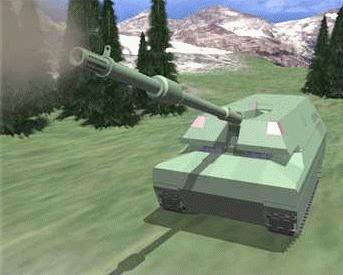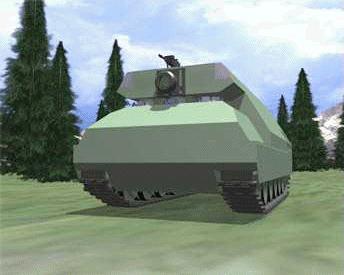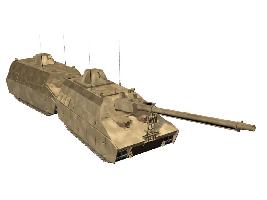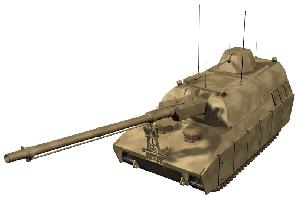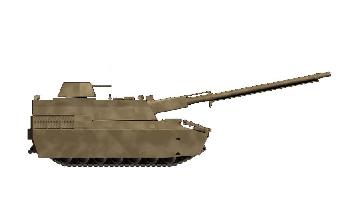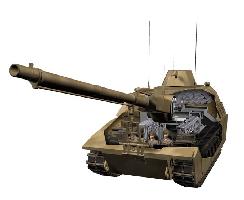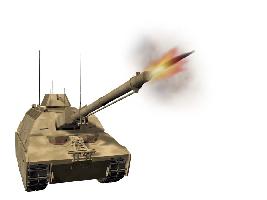
Secretary of Defense Donald H. Rumsfeld announced that the Deparment of Defense was terminating the Crusader program in favor of developing technologies for the Army's Future Combat System in mid-May 2002. Arguing that the Crusader, too heavy and too far from production, no longer served the needs of a military that must be characterized by mobility, agility, and precision, Rumsfeld recommended that funds allocated for the Crusader program be reallocated to assist in the development of other future technologies. Congress has placed a hold on the termination pending investigation of the Department of Defense's decision-making process and further deliberation after significant public outcry from Army officers, lobbyists, and congressman. (See Rumsfeld's Testimony 16 & 21 May 2002)
The Fiscal Year 2001 Army budget request included decisions to restructure or "divest" a number of programs in order to provide some of the resources to support its transformation to achieve the ambitious deployment goals outlined in the October 1999 Army Vision. The restructured programs are the Crusader and the Future Scout and Cavalry System. The "divestitures" include Heliborne Prophet (Air), MLRS Smart Tactical Rocket (MSTAR), Stinger Block II, Command and Control Vehicle (C2V), Grizzly, Wolverine, and the Army Tactical Missile System Block IIA. Funding for these programs was reallocated to fund the Army Vision transformation strategy.
The Army restructured the Crusader program to gain improvement in indirect fire support capability and reducing the overall weight of the system while maintaining all key performance parameters (lethality and mobility). The decision to restructure the Crusader was based on affordability and its compatibility with the Army Vision. By restructuring Crusader the Army saves $11.2 billion between FY00 and FY14. The restructure strategy includes partially satisfying the Army howitzer requirement by continuing to use Paladin and LW155 howitzer platforms, reducing the number of Crusaders from 1,138 to 480, and reducing system weight to 40 tons or less to equip III Corps divisions.
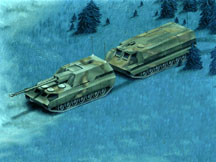 The Crusader system, formerly known as Advanced Field Artillery
System (AFAS), consists of an automated
155 mm self propelled howitzer (SPH) and a resupply vehicle (RSV) operated by three crew members in each vehicle. The Crusader artillery system, including its dedicated resupply vehicle, will be the Army's 21st
century self-propelled howitzer and will provide artillery support to the maneuver forces on the future battlefield. The system, will utilize innovative propellant technologies to propel 155mm rounds to ranges up to 50 kilometers and will be capable of firing 10-12 rounds per minute. In addition, the Crusader will be able to fire up to eight rounds which can impact simultaneously on a target. These new features will greatly increase artillery forces' lethality and versatility and will provide a significant increase in battlefield tempo. PM Crusader, with matrix support from TACOM-ARDEC, is also helping to develop a dedicated support vehicle which will provide ammunition, propellant, fuzes and fuel to the forces in the field. Both the self-propelled howitzer and the resupply vehicle will utilize state-of-the-art robotic handling systems which will decrease the time and number of
personnel needed for resupply. In addition, these systems will be capable of maintaining speed and maneuverability with forces at the front lines of the battle. TACOM-ARDEC is involved in all aspects of Crusader's development, currently in the demonstration and validation phase, through fully integrated product development teams. The Crusader self-propelled howitzer will provide soldiers with a more lethal, capable, supportable, survivable, longer range, and less manpower-intensive field artillery system which will meet the user's needs well into the 21st century.
The Crusader system, formerly known as Advanced Field Artillery
System (AFAS), consists of an automated
155 mm self propelled howitzer (SPH) and a resupply vehicle (RSV) operated by three crew members in each vehicle. The Crusader artillery system, including its dedicated resupply vehicle, will be the Army's 21st
century self-propelled howitzer and will provide artillery support to the maneuver forces on the future battlefield. The system, will utilize innovative propellant technologies to propel 155mm rounds to ranges up to 50 kilometers and will be capable of firing 10-12 rounds per minute. In addition, the Crusader will be able to fire up to eight rounds which can impact simultaneously on a target. These new features will greatly increase artillery forces' lethality and versatility and will provide a significant increase in battlefield tempo. PM Crusader, with matrix support from TACOM-ARDEC, is also helping to develop a dedicated support vehicle which will provide ammunition, propellant, fuzes and fuel to the forces in the field. Both the self-propelled howitzer and the resupply vehicle will utilize state-of-the-art robotic handling systems which will decrease the time and number of
personnel needed for resupply. In addition, these systems will be capable of maintaining speed and maneuverability with forces at the front lines of the battle. TACOM-ARDEC is involved in all aspects of Crusader's development, currently in the demonstration and validation phase, through fully integrated product development teams. The Crusader self-propelled howitzer will provide soldiers with a more lethal, capable, supportable, survivable, longer range, and less manpower-intensive field artillery system which will meet the user's needs well into the 21st century.
The Crusader SPH and RSV, formerly known as the Advanced Field Artillery System (AFAS) and Future Ammunition Resupply Vehicle (FARV), were originally two of the five common chassis vehicles in the Army's Armored Systems Modernization (ASM) program. The other vehicles were a Block III tank, a Future Infantry Fighting Vehicle, and a Combat Mobility Vehicle. The changing threat and budget realities led to a restructuring of the ASM program that deferred all the ASM components except Crusader.
The SPH was originally expected to have a regenerative liquid propellant gun armaments system. ). The underlying mechanism of liquid propulsion consists of the injection of a fluid propellant through the annulus formed by two moving pistons into a combustion chamber, where the ensuing combustion causes acceleration of the projectile.
Although the Crusader self-propelled howitzer (SPH) may outwardly resemble a tank, it is not and has a drastically different battlefield role. A tank is a front line, close combat weapon whose main armament operates on a direct fire principle (i.e., a direct line of sight is obtained to the target and used to orient the weapon). The Crusader SPH operates on the artillery principle of indirect fire (i.e., a direct line of sight is not used to orient the weapon), although direct fire can be employed if the situation dictates. Usually, the SPH is located several kilometers (km) behind front lines and delivers fires upon designated targets based upon coordinates transmitted digitally by forward observation personnel, intelligence or target acquisition systems (e.g., radars, reconnaissance systems, remotely piloted vehicles, aerial surveillance systems, etc).
The Crusader SPH is designed to meet the demands of a 21st century self-propelled, indirect fire support system. The fully automated weapon system is capable of delivering a wide array of lethal 100 pound, 155 mm diameter projectiles onto designated targets within 40 km. The emplaced SPH will fire the first round within 15-20 seconds of acknowledging a mission, or if the vehicle is on the move, 30-45 seconds after the fire mission is received. The weapon is capable of a maximum rate of fire of 10 rounds/minute for the first 3 minutes, followed by a sustained rate of between 3 and 6 rounds/minute until all on board ammunition is depleted. The system is also capable of executing multiple round (8 maximum) simultaneous impact (MRSI) missions. A MRSI mission is a sophisticated operation which requires several rounds to be fired in rapid succession, all at different elevations and velocities. The end result is that the multiple rounds reach the intended target at distances of 5-30 km within 4 seconds from first to last round impact. The vehicle's suspension and drivetrain are designed to operate at sustained road speeds of 67 kilometers per hour (kph) and cross-country speeds of 39 kph. The crew operates all system functions through a user-friendly computer interface in a sealed, temperature controlled, NBC protected compartment. There is no physical involvement required of the crew unless maintenance actions are required.
Unlike the current M109 series SPHs in service with the US Army, the Crusader SPH is a fully automated system. The weapon functions are remotely operated from the crew compartment using the onboard computer system. The computer receives a digitally transmitted fire mission and notifies the crew of a recommended weapon azimuth and elevation as well as the projectile and propellant charge combination(s) to fulfill the mission. The crew is only required to confirm and authorize the fire command. The automated weapon system is then brought to the correct orientation, loaded and fired. The system is capable of a ±20° azimuth with elevations between -3° and 70°. In the event the weapon must be oriented beyond the ±20° window, the crew can perform a pivot steer to meet the correct azimuth within a matter of seconds. (A pivot steer is the process of turning one set of tracks while leaving the other set immobile, thereby causing the vehicle to rotate either clockwise or counterclockwise.)
The SPH main armament consists of the XM297E2 cannon, the XM200 gun mount and an automatic weapon loader. The cannon, which was specially designed for the Crusader system, is a 56 caliber tube (for large weapons, caliber is a ratio of tube length to bore diameter). A unique feature of the cannon tube is the employment of a full length cooling jacket using isopropyl glycol as the fluid medium. By dissipating gun tube heat through heat exchangers located in the turret, the active cooling system helps to provide a higher rate of fire, reduce tube wear and increase accuracy. Incorporated into the end of the tube is a pepper pot muzzle brake. This design employs a series of longitudinal rows of holes circumferentially around the tube. The holes are drilled at an angle that enables a rearwards venting of the gasses behind the expelled projectile, thereby providing a brake to the recoiling cannon (this is the backwards motion of the cannon caused by firing a projectile). Capping off the load end of the tube is a vertically sliding breech block coupled with a laser ignition system.
The SPH is capable of carrying a maximum of 60 fuzed projectiles within an active storage system (i.e., individual storage cells are mobile) comprised of two separate magazines located in the vehicle center. Each 30 round magazine is a closed-loop conveyor which cycles the desired projectile/fuze combination to a loading position accessible by the shuttle.
Located at the rear of the SPH turret bustle is a resupply port which provides for the fully automated transfer of fuzed projectiles, propellant, fuel and electronic data between the SPH and the RSV. After entering the port, the projectiles move by conveyor to the autoloader, which transfers the projectile to the shuttle for insertion and storage in the projectile magazines. Although all projectiles can be transferred and loaded prior to the propelling charges, the preferred method is to alternate propellant and projectiles. Located just inside the resupply port is the propellant shuttle which grips the charges as they enter the port and inserts them into the propellant magazine cells. Along with the projectiles and charges, electronic data identifying projectile/fuze combinations and propellant type are furnished to the SPH computer which records the respective magazine locations for future retrieval.
The system is capable of being completely resupplied (60 fuzed projectiles and 270 charges) in under 12 minutes, including the time needed to dock/undock with the RSV. During the rearm process with the RSV, fuel is transferred at the rate of 29.5 gallons/minute (65 liters/minute) through the resupply port. In the event that an RSV is unavailable to perform an automated resupply, the capability to manually resupply exists. Projectiles and propellant are resupplied through the same port, while a fuel inlet is provided on the chassis.
This is the first U.S. field artillery system to incorporate an automated ammunition and fuel loading and transfer system. Developing this computer-driven, mechanical system and the RSV-SPH docking system will be a greater challenge than developing a traditional howitzer and resupply ammunition handling system.




